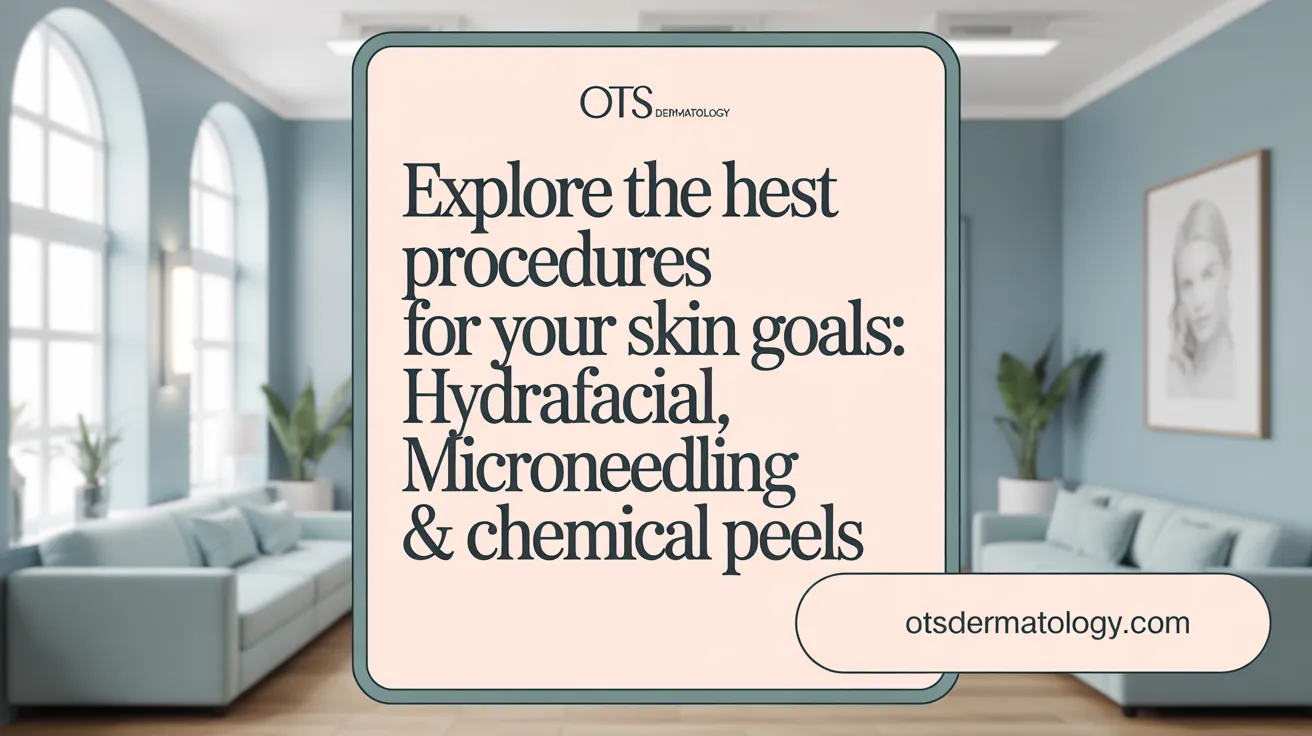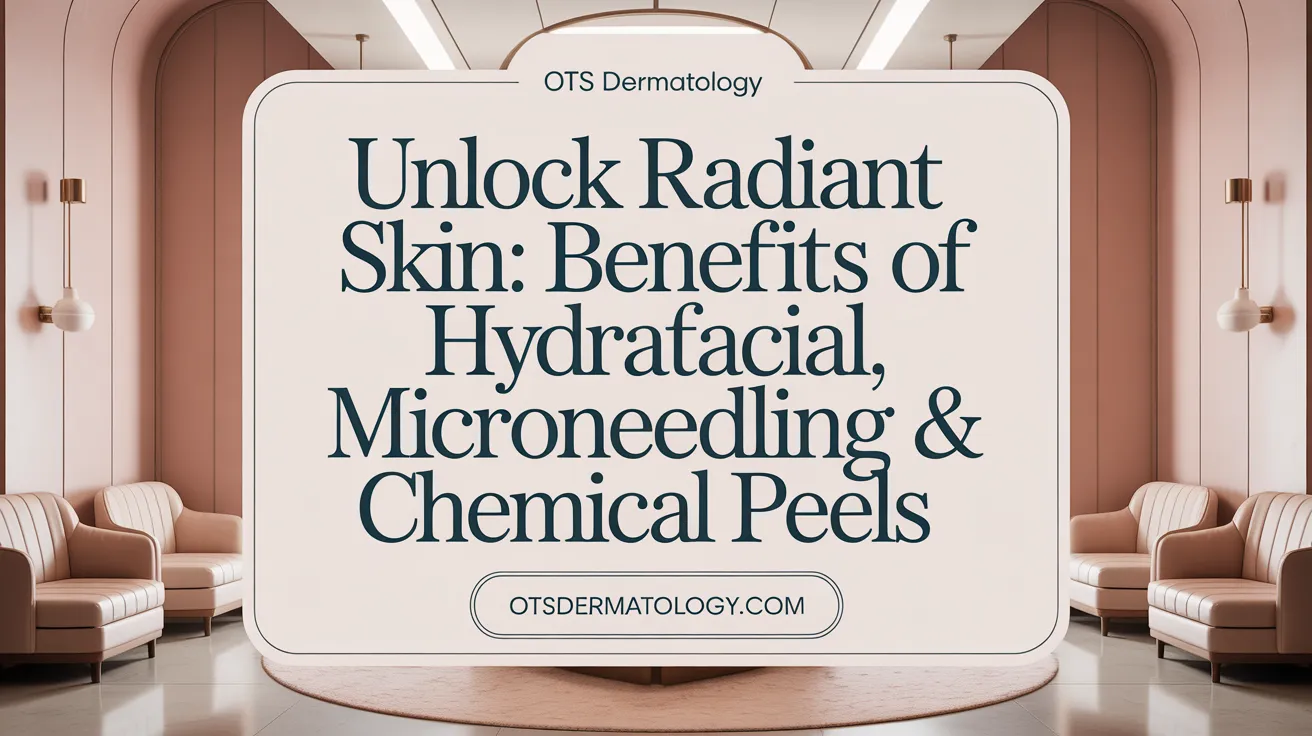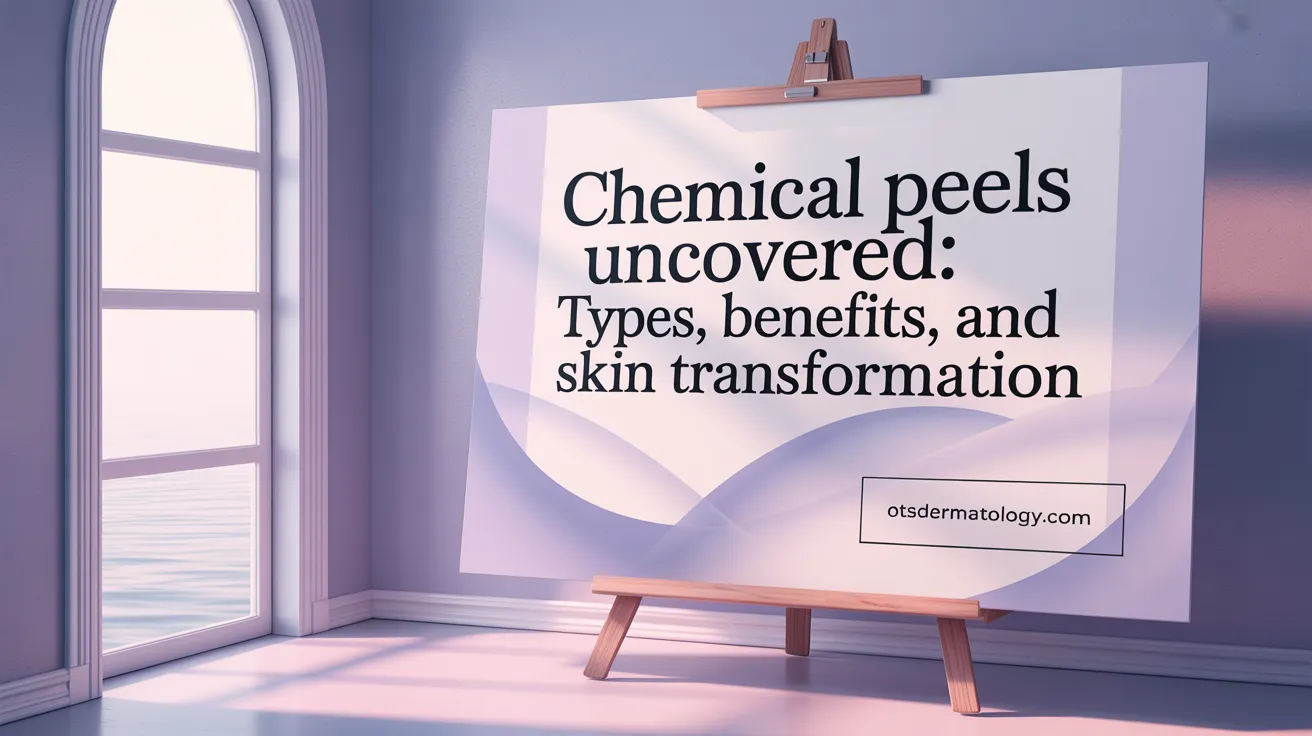Introduction to Popular Skin Treatments
In the dynamic world of skincare, Hydrafacial, Microneedling, and Chemical Peels stand out as leading treatments for rejuvenation and addressing various skin concerns. Each offers unique benefits through distinct procedures, catering to different skin types and conditions. This article delves into their differences, benefits, suitability, and how to select the most appropriate treatment for your skin health goals.
Understanding Hydrafacial, Microneedling, and Chemical Peels: Procedures and Suitability

What is Hydrafacial and how does it work?
Hydrafacial is a non-invasive skin treatment that combines cleansing, exfoliation, extraction, and hydration using specialized vortex fusion technology in HydraFacial. This device gently removes impurities, dead skin cells, and promotes blood circulation while infusing the skin with antioxidant-rich serums. It’s designed to improve skin texture, hydration, and overall radiance with no downtime required. Suitable for nearly all skin types, including sensitive skin, Hydrafacial provides immediate visible results, making it popular for regular maintenance and targeted skin concerns such as dullness, fine lines, and hyperpigmentation.
How does Microneedling stimulate the skin?
Microneedling, also called collagen induction therapy, involves using fine needles to create tiny controlled punctures on the skin surface. These micro-injuries trigger the body’s natural healing process, stimulating increased production of collagen and elastin, which leads to firmer, smoother, and more youthful skin. It is especially effective for reducing acne scars, wrinkles, hyperpigmentation, and stretch marks. The procedure is minimally invasive with little discomfort, and results develop gradually over several weeks after multiple sessions.
What are the different types of chemical peels?
Chemical peels involve applying a chemical solution to the skin, which causes controlled exfoliation and removal of damaged outer layers. There are three main types:
- Superficial (Light) Peels: Use mild acids like glycolic or salicylic acid, suitable for minor imperfections and requiring minimal or no recovery time.
- Medium Peels: Use stronger chemicals like TCA to treat moderate wrinkles, uneven skin tone, and scars, with a recovery period of about a week.
- Deep Peels: Involve phenol or high-strength TCA, addressing severe wrinkles and scars but with longer downtime and more risks. Each type targets different skin conditions, and the choice depends on skin type, concern severity, and desired results. For more detail, see the overview of the Types of Chemical Peels.
Suitability for Different Skin Types
- Hydrafacial: Ideal for all skin types—oily, dry, sensitive, or combination—due to its gentle yet effective nature (HydraFacial benefits).
- Microneedling: Suitable for most skin types, including darker skin tones and those with concerns like scars and sagging; less ideal for active acne or inflamed skin (Microneedling procedure and safety).
- Chemical Peels: Suitability varies; superficial peels are safe for most, but medium and deep peels require careful selection, especially for darker skin, to avoid hyperpigmentation or scarring (Chemical peel risks and recommendations).
Choosing the appropriate treatment involves considering specific skin issues, skin type, and recovery capacity. Consulting with a dermatologist ensures a personalized and effective skincare plan.
Benefits and Advantages of Each Treatment for Skin Health

What are the benefits and advantages of Hydrafacial, Microneedling, and Chemical Peels for skin health and common skin conditions?
HydraFacials are highly regarded for their gentle, non-invasive approach to skin cleansing, exfoliation, and hydration. They use advanced vortex fusion technology in HydraFacial to remove impurities, hydrate the skin with antioxidant serums, and improve overall skin glow and texture. Suitable for all skin types, including sensitive skin, HydraFacials deliver immediate visible results such as smoother, more radiant skin, with no downtime required. They are especially effective at reducing dullness, enlarged pores, fine lines, and hyperpigmentation, making them ideal for ongoing skin maintenance (HydraFacial benefits, HydraFacial benefits and features, HydraFacial benefits duration).
Microneedling stimulates the skin's natural healing process by creating controlled micro-injuries using fine needles. This process boosts collagen and elastin production, which are crucial for skin firmness, elasticity, and youthful appearance. It effectively reduces the appearance of scars, acne scars, hyperpigmentation, and fine lines. Typically performed over multiple sessions, microneedling produces gradual, long-lasting improvements in skin texture and firmness. It is also safe for most skin types and helps in reversing sun damage and aging signs (Benefits of Microneedling, Microneedling skin procedure explained, Microneedling recovery and side effects).
Chemical peels involve applying safe chemical solutions to remove damaged outer skin layers, encouraging cellular turnover and regeneration. Depending on their depth—superficial, medium, or deep peels—chemical peels address a variety of skin concerns including wrinkles, scars, uneven pigmentation, sun damage, and melasma. Superficial peels offer minimal downtime and mild exfoliation, while medium and deep peels produce more dramatic results with longer recovery periods. They improve skin overall texture and tone, reduce signs of aging, and can be customized for individual skin conditions (Benefits of chemical peels, Types of chemical peels, Chemical peels overview).
How can combining these treatments enhance skin rejuvenation?
Combining treatments such as HydraFacial with chemical peels or microneedling can maximize skin rejuvenation. For instance, a HydraFacial can prepare the skin by removing impurities and hydrating, creating a better base for deeper peel or microneedling treatments. Conversely, chemical peels can enhance results by removing surface damage, allowing subsequent microneedling or HydraFacial sessions to penetrate more effectively (Combining HydraFacial and chemical peels, Combination of microneedling and chemical peels).
Personalized skincare plans, guided by dermatologists or skincare professionals, can target specific concerns like hyperpigmentation, dullness, scars, or aging. Such combinations provide a comprehensive approach to improving skin health, appearance, and resilience (Treatment recommendations for skin concerns, Consulting dermatologists for skin treatments).
Overall, each treatment has unique benefits: HydraFacial for quick hydration and nourishment, microneedling for collagen induction and scar reduction, and chemical peels for deeper skin renewal. When used together under professional guidance, they offer powerful, customized solutions for a variety of skin issues (HydraFacial vs Microneedling, Microneedling vs. Chemical Peels, Chemical Peels Overview).
How do these treatments suit individual skin conditions?
Choosing the right treatment depends on the skin's needs and concerns. HydraFacials are perfect for maintaining overall skin health and hydration, tackling dullness and congested pores (HydraFacial suitability for all skin types). Microneedling is excellent for addressing deeper wrinkles, scars, and skin laxity (Microneedling for collagen production). Chemical peels are suitable for improving hyperpigmentation, sun damage, and more persistent surface irregularities (Chemical peels for skin tone).
Consulting with a skincare specialist is essential to develop a tailored plan that combines these therapies effectively. This ensures safe, effective, and lasting improvements aligned with personal skin goals (Choosing the right facial treatment, Professional skin treatment consultation).
Choosing the Right Treatment Based on Skin Concerns and Types
 Selecting the most suitable skincare treatment depends on understanding your individual skin concerns, skin type, and lifestyle needs. For example, those seeking hydration and mild exfoliation often find HydraFacial to be an excellent option. This treatment is non-invasive, suitable for all skin types, including sensitive skin, and provides immediate results in skin brightness, hydration, and improved texture (HydraFacial benefits, HydraFacial for sensitive skin, HydraFacial benefits and features).
Selecting the most suitable skincare treatment depends on understanding your individual skin concerns, skin type, and lifestyle needs. For example, those seeking hydration and mild exfoliation often find HydraFacial to be an excellent option. This treatment is non-invasive, suitable for all skin types, including sensitive skin, and provides immediate results in skin brightness, hydration, and improved texture (HydraFacial benefits, HydraFacial for sensitive skin, HydraFacial benefits and features).
Microneedling is especially effective for targeting deeper skin issues such as scars, wrinkles, and signs of sun damage. It stimulates collagen production through controlled micro-injuries and is safe for most skin types, including darker skin tones. However, it may require multiple sessions and some downtime for redness and swelling (Microneedling procedure, Microneedling benefits, Microneedling for scars and acne, Microneedling safety).
Chemical peels offer customizable options ranging from superficial to deep treatments, depending on individual skin conditions. Superficial peels can improve surface texture and tone with minimal recovery, while medium and deep peels address more severe aging signs, hyperpigmentation, and scars, but involve longer healing processes and care (Types of chemical peels, Benefits of chemical peels, 3 depths of chemical peels, Chemical Peels for Skin Resurfacing).
Factors influencing treatment choice include the specific skin concern (like hyperpigmentation or scars), skin sensitivity, and the amount of downtime a person can accept. For mild issues or maintenance, HydraFacial works well. For more significant collagen boost and scar reduction, microneedling may be preferred. Deeper skin concerns may benefit from chemical peels, especially when tailored to skin type (Treatment recommendations for skin concerns).
Ultimately, consulting a qualified dermatologist or skincare professional is crucial. They can evaluate your skin, review your medical history, and recommend a personalized treatment plan. This ensures safety and effectiveness, helping you achieve optimal skin health and a youthful appearance (Professional skin treatment consultation, Consulting dermatologists for skin treatments).
Deep Dive into Chemical Peels: Types and Skin Benefits

What types of chemical peels are available, and how do they work to improve skin health?
Chemical peels are classified into three main categories based on their depth of skin penetration: superficial, medium, and deep peels.
Superficial peels employ mild acids such as alpha-hydroxy acids (like glycolic acid) to gently remove the outermost layer of skin. This process helps improve skin tone, texture, and minor discolorations with little to no downtime.
Medium peels penetrate deeper into the epidermis and upper dermis using stronger agents like trichloroacetic acid (TCA). They are effective for moderate wrinkles, sun damage, and pigmentation issues, producing more noticeable results but requiring a recovery period.
Deep peels involve the use of potent chemicals such as phenol to reach the deep dermal layers. These are reserved for severe photoaging or significant scars. Deep peels offer dramatic skin renewal but come with longer healing times and higher risks.
All peel types work by removing damaged or aged skin layers, stimulating the growth of new, healthier cells, and boosting collagen production. For a detailed overview of chemical peels and their benefits and the 3 depths of chemical peels, please refer to these resources.
Specific issues treated by different peel depths
| Peel Type | Skin Concerns Addressed | Typical Downtime | Example Formulations |
|---|---|---|---|
| Superficial | Fine lines, mild sun spots, uneven tone, dryness | None or minimal (a few days) | Glycolic acid, lactic acid, salicylic acid |
| Medium | Wrinkles, age spots, moderate scars, pigmentation | About 1-2 weeks | TCA solutions, Jessner’s solution |
| Deep | Deep wrinkles, significant scars, precancerous lesions | Several weeks, extensive care | Phenol-based solutions |
Preparation and recovery considerations for peels
Before undergoing a chemical peel, individuals should avoid excessive sun exposure, discontinue retinoids or other irritating skincare products, and follow a dermatologist's guidance on skin priming. More about chemical peel preparation and risks.
Post-peel, skin may be red, swollen, or peeling, with recovery times varying by peel depth. Superficial peels often require no downtime, while medium and deep peels necessitate diligent aftercare, including sun protection and moisturization.
Choosing the appropriate peel depends on your skin type, concerns, and desired results, making professional guidance essential to maximize benefits and minimize risks. Learn more about chemical peel recovery and aftercare and treatment recommendations for skin concerns.
More information
For a comprehensive understanding of how chemical peels renew skin and which peel type suits your needs, search for "Types of chemical peels" and "chemical peel skin renewal mechanism". These searches will provide detailed insights into peel procedures, benefits, and recovery tips.
Targeted Treatments for Specific Skin Concerns: Aging, Scars, and Pigmentation
What are the best treatments for wrinkles and signs of aging?
Addressing wrinkles and aging involves a variety of procedures that stimulate collagen production or relax facial muscles. Microneedling is highly effective for reducing fine lines and encouraging skin rejuvenation by creating controlled micro-injuries that prompt collagen growth.
Laser skin resurfacing, either ablative or non-ablative, helps improve skin texture and reduce wrinkles by removing damaged skin layers and promoting new collagen formation.
Chemical peels, especially medium and deep options, can smooth out fine lines and deep wrinkles through deep exfoliation and skin regeneration.
Injectables like Botox temporarily relax the muscles that cause dynamic wrinkles, offering quick and visible improvements. Dermal fillers can restore lost volume, reducing sagging and deep lines.
Each treatment can be combined for enhanced effects, but consulting a dermatologist is essential to choose the right approach based on individual skin condition and goals. For more details on comparing microneedling, chemical peels, and laser treatments, see Microneedling vs Chemical Peels.
How are scars and acne marks best treated?
For scars, particularly acne scars, microneedling and laser resurfacing are popular options. Microneedling stimulates collagen to remodel scar tissue, resulting in smoother skin. Laser treatments target scar tissue and promote healthy new skin growth.
Dermabrasion and chemical peels with medium or deep penetration also improve scar appearance by removing outer damaged layers and encouraging regeneration.
For hyperpigmentation associated with scars, chemical peels like TCA peels or Jessner’s can help lighten dark areas by removing discolored surface layers.
Combining treatments often yields the best results, particularly for stubborn or deep scars, under professional supervision. See more on Chemical Peels and Microneedling for Scars.
Do peels and microneedling effectively reduce dark spots and hyperpigmentation?
Yes, both chemical peels and microneedling are effective for treating dark spots and hyperpigmentation. Light chemical peels with alpha and beta hydroxy acids are excellent for superficial pigmentation issues, promoting surface renewal.
Medium-depth peels like TCA peels penetrate deeper to target stubborn hyperpigmentation and melasma, with more noticeable results but longer recovery.
Microneedling enhances skin regeneration by stimulating collagen, which can gradually reduce pigmentation and even out skin tone, especially when combined with specific depigmentation serums.
Laser therapies, such as IPL, might also be recommended for pigmentation. Consulting with a professional ensures appropriate treatment selection based on the type and depth of discoloration. For additional comparison, see Microneedling vs Chemical Peels.
What role does Hydrafacial play in mild skin concerns and regular maintenance?
HydraFacial is ideal for maintaining overall skin health and addressing mild concerns like dullness, dehydration, and minor pigmentation. It combines cleansing, gentle exfoliation, hydrating serums, and antioxidant infusion within a non-invasive, comfortable procedure.
This treatment offers immediate glow and improved skin tone, making it perfect for regular monthly maintenance. It also helps keep pores clear and enhances the effectiveness of other skin treatments.
Hydrafacial is suitable for sensitive skin and can be customized with add-on boosters targeting specific concerns, making it a versatile tool for skin health upkeep. Learn more about the HydraFacial benefits.
Why is consultation important for personalized skin treatment plans?
Every individual’s skin is unique, with different concerns, sensitivities, and aging patterns. Consulting with a qualified dermatologist or skincare professional is vital to develop a tailored treatment plan that addresses specific issues like wrinkles, scars, or pigmentation.
A thorough skin assessment helps identify the underlying causes of skin problems and determines the most effective combination of treatments, whether it includes microneedling, peels, laser therapy, or injectables.
Personalized plans not only optimize results but also minimize risks and side effects, ensuring that treatments are safe and appropriate for the patient’s skin type and condition.
Always seek expert advice before starting any skin rejuvenation procedure to achieve the best, long-lasting outcome. See more about Choosing the Right Skin Treatments.
Exploring Other Skin Rejuvenation Procedures and Treatment Suitability
 Beyond HydraFacials, microneedling, and chemical peels, numerous other procedures enhance skin rejuvenation. Laser treatments, including ablative and non-ablative fractional lasers, target deeper skin layers to reduce wrinkles, scars, and pigmentation, stimulating collagen and tightening the skin. Microdermabrasion offers a gentle exfoliation ideal for minor skin concerns such as dullness and uneven texture, using either aluminum oxide or diamond-tipped devices.
Beyond HydraFacials, microneedling, and chemical peels, numerous other procedures enhance skin rejuvenation. Laser treatments, including ablative and non-ablative fractional lasers, target deeper skin layers to reduce wrinkles, scars, and pigmentation, stimulating collagen and tightening the skin. Microdermabrasion offers a gentle exfoliation ideal for minor skin concerns such as dullness and uneven texture, using either aluminum oxide or diamond-tipped devices.
Injectable options like dermal fillers and botulinum toxin (Botox) provide non-surgical avenues for improving facial contours and reducing dynamic wrinkles by adding volume or relaxing muscle activity. These treatments are particularly effective in addressing volume loss and fine lines, offering immediate or quick results.
The selection of appropriate procedures heavily depends on individual skin type and condition. Sensitive skin conditions or active inflammation may require gentler approaches to prevent irritation, whereas oily or acne-prone skin benefits from treatments that regulate sebum and clear pores. Conversely, dry or aging skin may need hydration-focused or collagen-stimulating therapies. For guidance on choosing treatments based on skin type, see Skin Treatments by Type and How to Choose the Right Facial Treatment.
Consulting with qualified dermatologists or skincare professionals is vital for designing personalized treatment plans. They can assess skin condition, recommend suitable options, and potentially combine different modalities—such as laser resurfacing with microneedling or peels—to maximize benefits. Combining treatments often yields more comprehensive results, addressing multiple concerns simultaneously.
Overall, understanding the broad spectrum of available skin rejuvenation treatments and tailoring them to individual needs ensures safer procedures and more satisfying outcomes, allowing patients to achieve healthier, more youthful-looking skin.
Conclusion: Tailoring Your Skincare Journey
Choosing the right skin treatment—whether Hydrafacial, Microneedling, or Chemical Peels—depends on a detailed understanding of your skin type, specific concerns, and desired outcomes. Hydrafacial offers a gentle, hydrating approach ideal for immediate and maintenance results across most skin types. Microneedling excels in stimulating collagen to improve deeper issues like scars and wrinkles but requires downtime and multiple sessions. Chemical peels provide customizable exfoliation for various skin concerns, from mild texture improvements to significant pigmentation and aging signs, with recovery varying by peel depth. Integrating professional evaluation and consultation is key to personalize treatment plans safely and effectively. Moreover, combining these treatments in a strategic skincare regimen can optimize skin health and rejuvenation, helping you reveal a radiant, youthful complexion that suits your unique skin needs.
